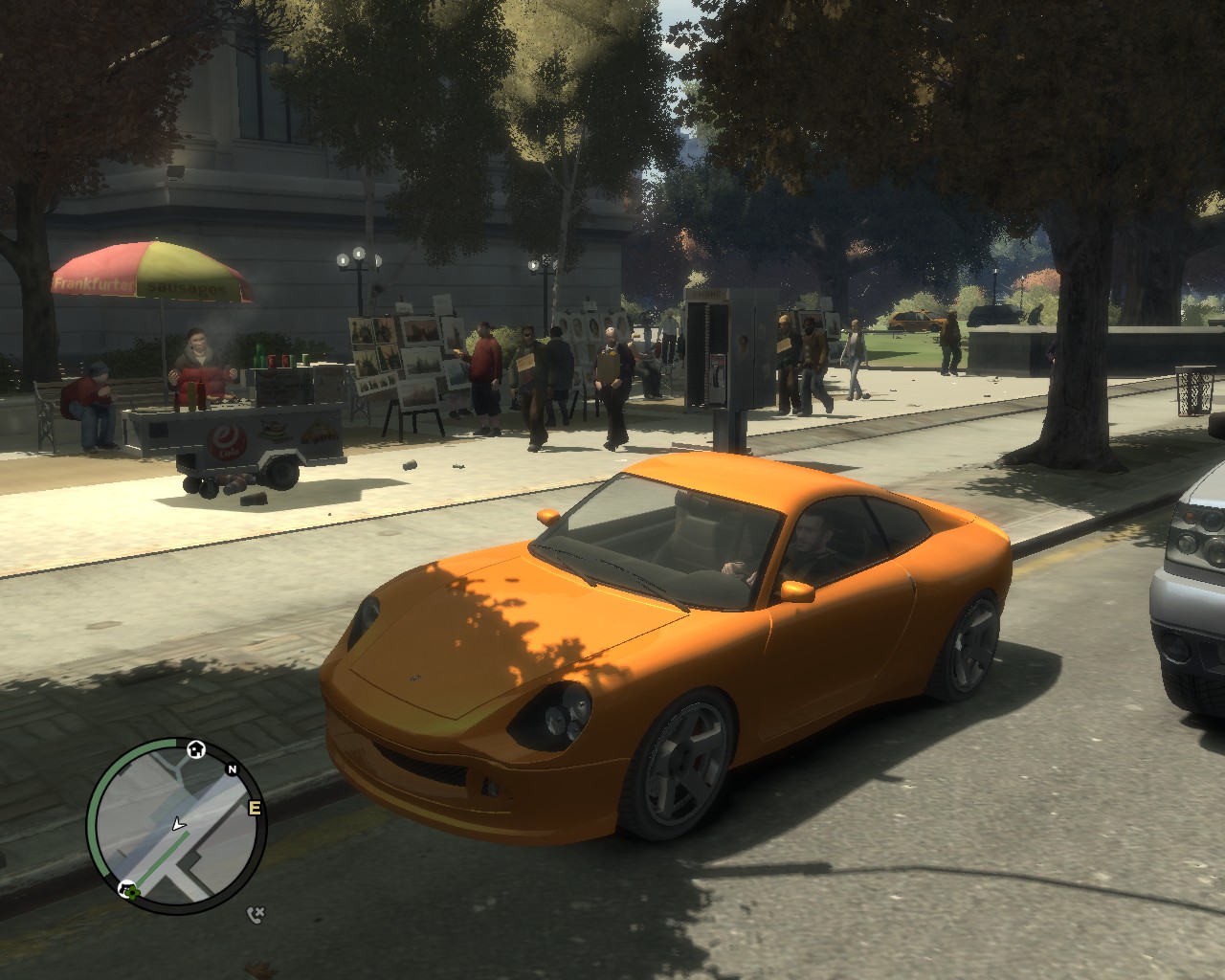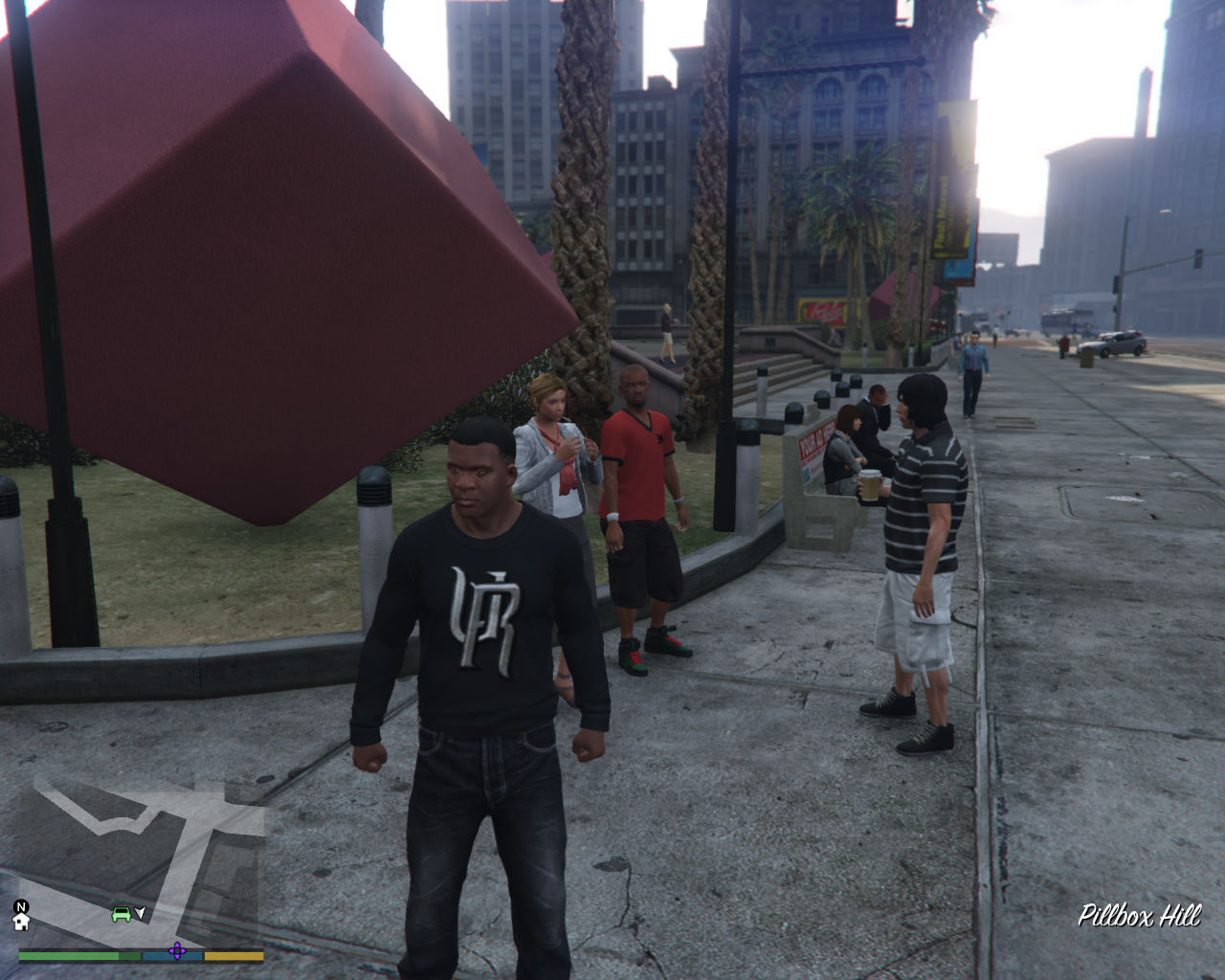Placemaking in the World of Grand Theft Auto
writing · · 5 min readSeveral weeks ago, I came across a lovely article on Kotaku about the opening act of Grand Theft Auto IV, in which immigrant protagonist Niko Bellic first arrives in a fictionalized United States and explores his newly adopted home of Liberty City.
As the author Kirk Hamilton explains, it’s a rather slow start for a GTA game. Niko undertakes some decidedly ordinary tasks — defending his cousin Roman from loan sharks, driving for his cab company, going out on a date — that ease us into the game’s driving and shooting mechanics. In the process, we are gradually introduced to Niko’s new social circle — a girlfriend, criminals to do business for, and Russian mobsters — and his surroundings, the run-down industrial neighborhood of “Hove Beach.”
While GTA IV was cautious and restrained, other Grand Theft Auto games thrust you immediately into the action. Just after the opening credits of Grand Theft Auto V, you were stealing a pair of supercars from a wealthy residence, racing through the streets of downtown Los Santos, and then escaping from the police. Similarly, 2004’s Grand Theft Auto: San Andreas inserted you right in the middle of a gang war, fleeing a drive-by shooting on a BMX bike and then smashing up a local crack den.
In GTA IV, we get a sense of how the Liberty City criminal world operates before we dive into the over-the-top car chases, assassinations, and SWAT shootouts — we see the loan sharks at Roman’s throat, the neighborhood crack dealers struggling for turf, and the shopkeepers being extorted for protection money. Taking things slow allows us to connect with Niko’s brave new world in a way that the chaotic exposition in San Andreas and GTA V does not, so suggests Hamilton in a brilliant summary of his GTA IV experience:
Each time I return to GTA IV, I want to leave Hove Beach less and less. I know I’ll never feel more immersed and attached than I do in those opening hours. Nowhere else in GTA IV feels as real or familiar to me as Hove Beach. Nowhere in GTA V does, either. For all of the newer game’s candy-coated indulgences and technical wizardry, it never matched its predecessor’s powerful sense of place.
I was struck by the idea that a video game like GTA IV could have a “sense of place” — what I would call a sense of a distinct culture and community within a specific moment, location, and universe. Urbanists, geographers, and sociologists alike speak of the greatest cities as having it. Architects strive for it. As Hamilton has already noted, one way GTA IV achieves a “sense of place” is through its meticulously crafted introduction. But how else does the game outshine GTA V, its universally acclaimed sequel?
One obvious answer lies in the two games’ drastically different settings. GTA IV’s Liberty City is a parody of New York City, America’s cultural and financial capital. NYC is the very definition of urban intrigue — the concrete jungle and subway, landmarks and neighborhoods that are household names, history that dates back to the discovery of North America, and a diverse ethnic makeup. If one wants to discover a sense of place, New York City — and by extension, Liberty City — is an urbanist’s paradise.
GTA V’s Los Santos is, of course, an imitation of Los Angeles. A city known for suburban sprawl and endless miles of freeways, where reality is defined by Hollywood and Disneyland. Every American can picture Manhattan, Brooklyn, Queens, and the Bronx, but few could name Irvine, Long Beach, Burbank, or Riverside. That’s because much of the LA region feels the same no matter where you happen to be within it, featuring the same templates of cookie-cutter, faux villages divided by six-lane arterials lined with palm trees. It’s all unmistakably Southern California — but it’s all unmistakably the same.
But in fact, such a shallow, sweeping generalization of Los Angeles sells the city short. LA is highly diverse, with ethnicities and cultures from all over the world. There’s the aforementioned templates of business districts with skyscrapers and suburbs with houses and strip malls, but there’s also ghettos, McMansions, heavy industry, Chinatown, and sun-soaked beaches — and buried beneath the region’s outward appearance of homogeneity is a fascinating history of corporate empires, interurban rivalries, and progressive nation-building.
Hamilton thinks that GTA V did not really succeed in giving Los Santos a sense of place — in other words, it failed to capture those features that make the real Los Angeles so unique. But on the surface, Rockstar’s effort should have been an unqualified success. The production of GTA V was a monumental technical achievement; the game’s graphics were widely praised as the best of the Xbox 360 and Playstation 3, and its rendition of Los Santos features uncanny imitations of iconic Los Angeles landmarks. It’s all there: the beaches, the parks, celebrity mansions, and miniature versions of Compton and East Los Angeles. One writer for The Verge claimed that Los Santos transcended reality, becoming more like Los Angeles than Los Angeles itself.
So what went wrong? A major shortcoming is that GTA V’s single-player story fails to actually explore these locations. A few missions venture into the ghetto or the trendy shopping district, but most of the campaign revolves around mischief in the countryside (that in no way resembles any part of rural California I’ve seen) or a proxy war between spoofs of the FBI and CIA set in downtown blockbuster sequences.
If one does bother to explore the parts of GTA V’s Los Santos not touched upon by the campaign, the city’s atmosphere is another cause for disappointment. Real cities are places where people can continuously interact in unique and intriguing ways, a process Jane Jacobs famously referred to as the “intricate sidewalk ballet.” GTA IV’s Liberty City nailed this: walk Niko down the street and he’ll find street vendors selling food, artists showing off their work, people carrying groceries, joggers getting a workout, and city workers caring for streets and landscapes. People of all social classes are represented, from homeless beggars to the comfortable middle-class to hotshot lawyers and businessmen.

Urban intrigue and social vitality on display in GTA IV’s Liberty City.
By comparison, GTA V feels fairly lifeless. Plenty of pedestrians can be found walking around Los Santos’s public parks, boardwalks, and shopping plazas, but they only wander aimlessly, sometimes talking on their cellphones. They also convey little diversity in social class or interests. In Liberty City, you feel for the poor Chinese immigrant struggling to keep his laundromat open, but in Los Santos, all anyone seems to do is obsess about celebrities and traffic.

The most prominent public spaces in GTA V, such as this parody of Pershing Square, tend to look empty and uninteresting.
The heart of GTA IV’s Liberty City is its residents, and the city could not exist without them. The opposite is true of Los Santos — its characters are merely props used for very specific purposes. Everyone in GTA V is an over-the-top caricature: a reckless gangster here, a psychotic middle-aged athlete there, a dumbed-down country bumpkin over there. These “people” don’t feel real. They’re certainly not relatable.
Maybe I can’t fault Rockstar entirely for how utterly alienating Los Santos can feel. The real Los Angeles’s geography is so widely dispersed that it’s easy to lose one’s frame of reference; given a city defined by miles and miles of nothingness, it’s perhaps no surprise that a fictionalized version would compensate for the lack of place by being bigger__, better, faster, louder beyond the point of believability.
In the end, I don’t know what to make of GTA V__‘s flaws. Are they the result of British video game developers failing to understand Los Angeles, or are they a biting, experiential critique on the sprawl and isolation so pervasive in the postmodern American city?